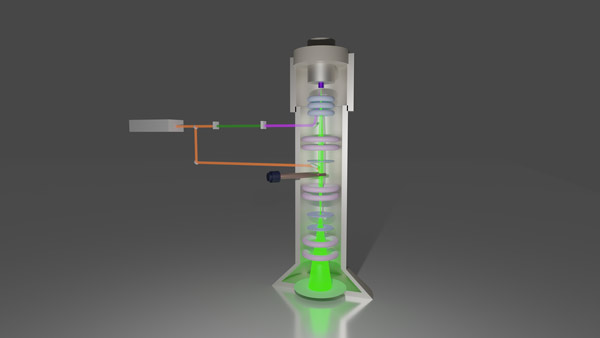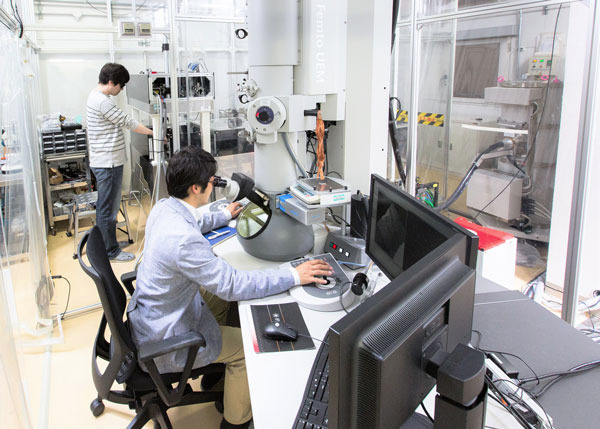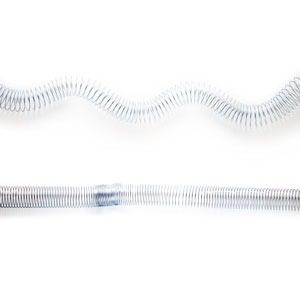
We investigate the electronic states of materials showing a variety of physical properties, functions, and quantum phenomena. By utilizing spin- and angle-resolved photoemission spectroscopy, which can probe the energy, momentum, and spin of electrons, we investigate new materials, topological quantum states, and many-body effects in strongly correlated systems. We are also developing the pulsed-laser based ultrafast transmission electron microscopy, aiming for probing the dynamical states of nanoscale spin/lattice/charge textures, materials, and devices.
Nano-to-micro spatiotemporal imaging of magnetic skyrmions
Magnetic skyrmions are self-organized topological spin textures that behave like particles. Because of their fast creation and typically long lifetime, experimental verification of skyrmion’s creation/annihilation processes has been challenging. Our team successfully tracked skyrmion dynamics in a room-temperature chiral magnet by using pump-probe Lorentz transmission electron microscope. Following the nanosecond photothermal excitation, we resolved 160-nm skyrmion’s proliferation at <1 ns, contraction at 5 ns, drift from 10 ns to 4 s, and coalescence at ~5 s. These motions relay the multiscale arrangement and relaxation of skyrmion clusters in a repeatable cycle. Such repeatable dynamics of skyrmions, arising from the weakened but still persistent topological protection around defects, enables us to visualize the whole life of the skyrmions and demonstrates the possible high-frequency manipulations of topological charges brought by skyrmions.

Spatiotemporal imaging of magnetic skyrmions recorded by ultrafast Lorentz electron microscope. https://www.science.org/doi/10.1126/sciadv.abg1322
Ultrafast nematic electron excitation in superconductor FeSe
The electronic nematic phase is an unconventional state of matter that spontaneously breaks the rotational symmetry of electrons. In iron-pnictides/chalcogenides and cuprates, the nematic ordering and fluctuations have been suggested to have as-yet-unconfirmed roles in superconductivity. In this study, we used femtosecond optical pulse to perturb the electronic nematic order in FeSe. Through time-, energy-, momentum- and orbital-resolved photoelectron spectroscopy, we detected the ultrafast dynamics of electronic nematicity. In the strong-excitation regime, through the observation of Fermi surface anisotropy, we found a quick disappearance of the nematicity followed by a heavily-damped oscillation. This short-life nematicity oscillation is seemingly related to the imbalance of Fe 3dxz and dyz orbitals, and shows a critical behavior as a function of pump fluence. Our real-time observations reveal the nature of the electronic nematic excitation instantly decoupled from the underlying lattice.

Time- angle-resolved photoelectron spectroscopy (upper left), schematic transient Fermi surface (lower left), and transient Fermi momentum obtained by real-time measurement (right).
Observation of topological electronic state emerging at the surface of a superconductor
There has been increasing interest on topological materials with non-trivial surface edge states (topological surface states). The topological surface states possess the massless Dirac electrons with their spins polarized perpendicular to their momenta, which give us chances to generate novel electromagnetic functions than cannot be found in bulks. The development of new topological materials including insulators, metals, and superconductors is being extensively examined. Here we utilized spin- and angle-resolved photoemission spectroscopy to investigate the surface and bulk states of a superconductor PdBi2. We found the spin-polarized surface bands emerging at the surface, which was proved to have the topologically non-trivial character by the Z2 analysis based on the first-principle calculations. Possible novel phenomena associated with the topological surface states and the superconductivity will be investigated in the future.

The band structures (left, center) and the spin polarization (right) obtained by the spin- and angle-resolved photoemission spectroscopy.








